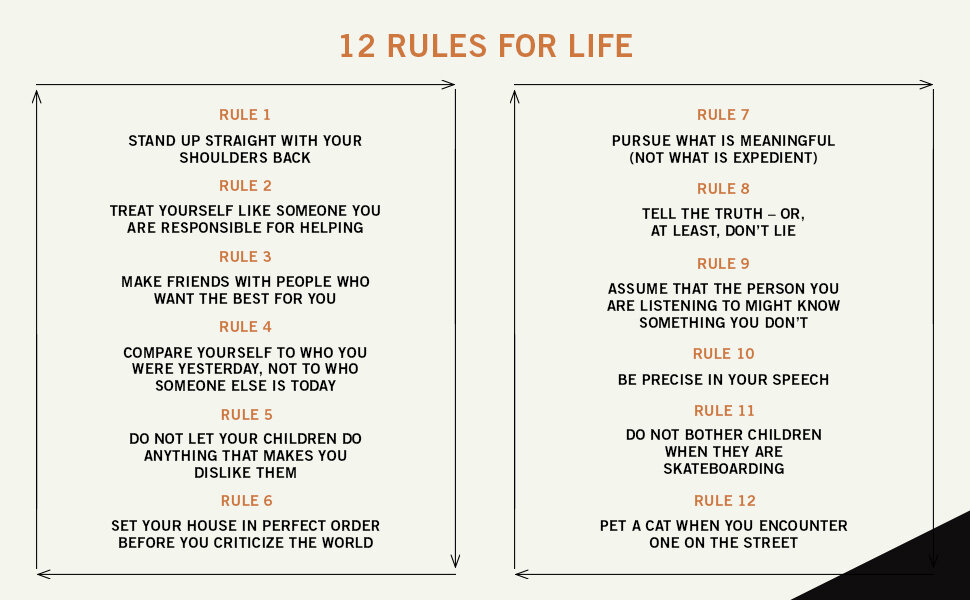Dr. Jordan B. Peterson is a clinical psychologist from Canada who, over the past few years, has become a well-known public figure. In this book, “12 Rules For Live: An Antidote to Chaos”, he outlines 12 simple rules to help with governing our own lives. These rules are not intended to be the only 12 rules by which to live our lives, but rather a baseline to help us be a better version of ourselves. If this is the first you have read about Dr. Jordan B. Peterson or this book, I hope I can pique your interest.
I was very methodical and intentionally slow in reading this book. I wanted and still want to absorb all of the lessons taught. I would encourage self-reflection while reading through each of these 12 rules.
This whole book has and will continue to influence me in more ways than I can adequately articulate here. I would like to point out specific rules which stuck out to me.
Rule #2 - Treat yourself like someone you are responsible for helping
I cannot tell you how many times I have handed out advice, encouragement, and direction which I would not even follow myself. Suggestions about health, spirituality, money, relationships, work, and more as though I had great sage wisdom worth following. I thought I was fulfilling my responsibility to help others…perhaps I was and still am. However, if I am not willing to be responsible for helping myself, how much will others value my suggestions?
As someone who is striving to be a better leader, I need to be leading myself before I am leading others. Am I investing in my future? Am I striving for growth? Am I building a life of significance? I need to be treating myself as someone I am responsible for helping.
Rule #6 - Set your house in perfect order before you criticize the world
The implications here…I stop to ponder. I likely cannot count the number of times I thought I could solve the world’s problems. How many times did I question a professional athlete’s decision under the pressure of a clutch moment? These are just the beginning of thoughts and conversations I have had where I allowed myself to ignore the mess in my own life, thinking I could fix someone else.
I have not, and likely may not ever set my house in perfect order. I have improved significantly over the past couple of years. I have set up disciplines in my life where I seek to improve myself, my life, my home, my relationships, and my finances. That is how I can change the world…by bettering myself.
Rule #9 - Assume that the person you are listening to might know something you don’t
This one reminds me of a Dalai Lama quote, “When you talk you are only repeating what you know; but when you listen you learn something new.” As a busy professional, I am often tempted to think that things need to happen now. There is no time to delay. In my mind, this means that everyone must listen to me because I have the right answers. When I push down that temptation, pause and listen to the ideas, thoughts, and suggestions of others then I am likely to get a clearer picture. Most often someone else’s recommendation will work out better than my own.
Even if I have to enforce my own decision, I need to at least hear the concerns and thoughts of those who will be responsible for helping to carry through with the steps needed for completion. I can explain my final intent, those in my care can get to that intent in the best way feasible within their realm of knowledge and expertise.
To clarify, my descriptions above are not how Dr. Jordan B. Peterson rolled out these 12 rules. The way it affected me is my take on my response as a result of reading this book. When you pick it up, read it with the intent to find how these rules apply in your own life.
When we are on a flight, and the plane is on its way to the runway, the flight attendants do their safety announcements. During their monolog, we are told that if the pressure drops in the cabin, and the masks fall in front of us, we put on our own mask before helping others secure theirs. In leadership, it is much the same. We need to be leading ourselves well before we can be qualified to have others call us their leader. 12 Rules For Life: An Antidote to Chaos, teaches areas where we can lead ourselves. Pick it up, read it, learn from it, you will not regret it.













